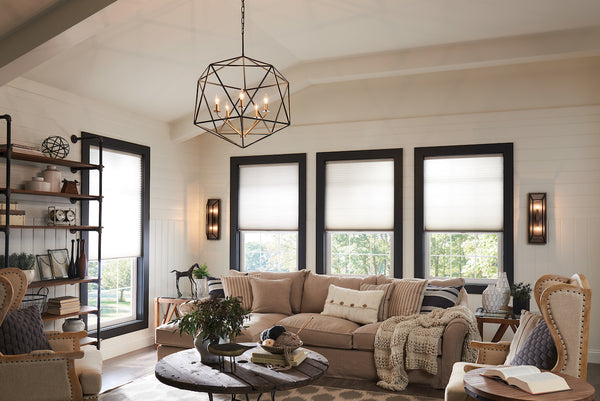On orders $99+
On orders $99+


In the expansive domain of interior design, the tide of trends ebbs and flows, each wave bringing forth new styles that capture hearts and minds. Among the modern-day design currents, Geometric Lighting has emerged as a luminary beacon, guiding aficionados towards a novel realm of aesthetic and functional illumination. This burgeoning trend is more than just a flash in the pan; it's a profound expression of modernity blended with the timeless allure of geometric forms.
Geometric Lighting is a riveting voyage away from the conventional to the realm of the extraordinary. It takes the rudimentary forms we learned in our early years - circles, squares, triangles, and parallelograms - and melds them into lighting fixtures that are anything but elementary. Each geometric lighting piece is a statement, a bold proclamation of individuality and modernity.
Why Geometric Lighting?
The allure of geometric lighting lies in its versatility and the bold statement it makes. It's a design style that has transcended the commercial sector's sleek interiors and found its way into the hearts and homes of contemporary design enthusiasts. This trend caters to the modern desire for clean lines, unique designs, and a break from tradition.
Implementing Geometric Lighting: A Step into Modernity
Statement Pieces: Embrace the boldness of geometric lighting by introducing statement pieces in your living or dining room. Imagine a large geometric chandelier suspended over a dining table; its sharp angles and clean lines juxtaposed against a soft, rustic table setting. The contrast is both arresting and aesthetically pleasing. This stark interplay of forms not only elevates the design aesthetics but also sparks conversations, making your dining area a lively hub of social interactions.
Harmonizing with Existing Decor: A common concern is the integration of geometric lighting with existing decor. The beauty of geometric forms is their ability to blend seamlessly with a multitude of styles, from the minimalist to the boho chic. For instance, a geometric pendant light with a matte black finish could lend a modern touch to a rustic kitchen. The geometric forms, with their sleek lines and angles, can provide a modern counterpoint to the organic, rough-hewn textures of a rustic decor, creating a design narrative that's rich in contrasts and visual interest.
Exploring Materials and Colors: Delve into the array of materials and colors available. A brass geometric fixture can inject a touch of elegance and warmth into a space, while a black or chrome finish can exude modernity and sophistication. Experimenting with materials and colors can also help address the challenge of matching geometric lighting fixtures with your existing decor. For instance, a rose gold geometric chandelier can add a touch of femininity and elegance to a room dominated by neutral tones and minimalist decor.
Creating Focal Points: Utilize geometric lighting to create focal points in your rooms. A pair of geometric sconces flanking a piece of art or a mirror can draw the eye and highlight the areas you want to accentuate. These geometrically inspired lighting fixtures act as visual anchors, guiding the eye through the room and creating a sense of balance and harmony in the space. They become more than just lighting fixtures; they transform into artistic expressions that enhance the aesthetic appeal of your room.
Mix and Match: Don’t shy away from mixing and matching different geometric forms. A mix of geometric table lamps, pendant lights, and a chandelier in the same space can create a visually stimulating environment that exudes modernity. Each geometric form can bring its own unique charm, and together they create a rich tapestry of shapes and lights that is visually engaging. This mix and match approach allows for a creative exploration of forms, offering an opportunity to create a unique lighting landscape that reflects your personal style and design sensibilities.
Navigating Challenges:
Designing with geometric lighting is an exciting venture, but it comes with its set of challenges. The key is to strike a balance; while geometric lighting is bold, it should not overwhelm the space. Too many geometric elements can create visual clutter. The trick is to find that sweet spot where the geometric lighting fixtures enhance and accentuate the space without dominating it.
Moreover, scale and proportion are crucial. It's essential to choose geometric lighting fixtures that complement the size and scale of your space. A geometric chandelier that's too large can overwhelm a small room, while a tiny pendant light can look lost in a spacious area.
Conclusion:
Geometric Lighting is more than a trend; it's a celebration of the modern ethos of design, a narrative of contemporary aesthetics. It offers a world of exploration for DIY homeowners and budding interior designers alike. As you venture into the geometric lighting design, you're not just illuminating spaces; you're crafting modern-day marvels of light and geometry, each fixture a testament to your design acumen. So, as you contemplate your next design project, consider stepping into the geometric light, where form meets function in a dance of shadows and beams, creating interiors that resonate with modernity and elegance.
Helpful Links:
Explore our collection of Geometric Lighting
Illuminating Harmony: The Art and Science of Layered Lighting
Leave a comment